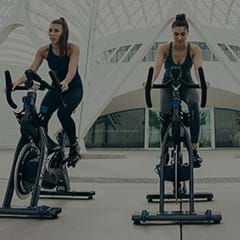If you choose the right group fitness workout there’s no real need to track your heart rate – the workout will be scientifically shaped and tested to push your body into the right heart rate zones at the right times. But heart rate tracking can still be very valuable. Les Mills Trainer Jim Berg says that monitoring your heart rate is great for feedback, motivation and keeping check on your training load. So we asked him more about how to do it right.
Why should you start monitoring your heart rate during group fitness workouts?
By becoming familiar with your heart rate during a specific workout you’ll see from session to session if you are improving and pushing yourself as hard as you should. You’ll learn when you can push harder, and when you need to recover during the workout. You´ll also be able to detect early warning signs if something is wrong with your health or your stress-levels.
With a heart rate monitor it’s easy to learn, grow, and improve your understanding about how your body responds to exercise. It is great for reflection and comparison, so that you can monitor fluctuations and establish norms. It is also particularly valuable if you’re a fan of high-intensity interval training, as recent research highlights the importance of avoiding too much time in the 90 percent-plus max zone.
So how can you adjust your workout if you’re doing a structured group fitness workout?
In a group fitness workout everyone is doing the same thing and truly experiencing the “group high”, but that still leaves a lot of room for personal variation. Les Mills Instructors will always provide options so you can always adjust the intensity by choosing easier or harder options depending on your training objective.
![]()
What are the common misconceptions about heart rate training?
The idea that more is better – that your heart rate should be high throughout a workout – is definitely one misconception. Another is the concept of using heart rate as a “high score” where the only goal is to achieve a specific heart rate and not consider the overall picture; what the heart tells you together with how you’re feeling and your knowledge about your own body. You should use your heart rate as just one tool to train smarter, and not aim to “hit the jackpot” based on heart rate alone.
What’s the one thing to know about heart rate monitoring that most people don’t?
Maximum heart rates vary a lot, so setting training zones based on values determined by the rule of thumb – 220 minus your age – won’t always deliver the opportunity for accurate monitoring. Controlling and adjusting workout intensity should be based on your individual threshold and daily capacity, not maximum heart rate. If you’re really serious, having your individual threshold determined in a lab will allow you to accurately monitor which training zone you are in.
![]()
What is the biggest mistake you can make when interpreting heart rate data?
Thinking that “more time in red is always better”, and not comparing it to what you’ve done before. The best proof that you are fitter than before is when you are able to maintain a higher heart rate for longer than you used to, or when your heart rate is lower while running or cycling at the same speed or output. So you need to look back to look forward, and determine how you are tracking.
The best proof that you are fitter than before is when you are able to maintain a higher heart rate for longer than you used to, or when your heart rate is lower while running or cycling at the same speed or output.
So, heart rate monitoring is clearly valuable but also part of a bigger picture.
Yes, it´s a truly great way to improve your understanding of your personal physiological response to exercise over time. Even if you’re not a tech geek who gets obsessed with the training diagrams and charts that are available, it’s a great, simple way to capture more feedback than simply how your workout “felt”.
If you’re after some more info on how to use heart rate tracking to find your sweet spot of exercise intensity, check out these tips from the experts at Polar. And you can learn about how to track your performance to avoid overtraining here.
Is heart rate tracking just for workouts?
Monitoring your heart rate around the clock can provide all sorts of valuable insights. It’s a great way to gauge the non-exercise activity thermogenesis (also known as the NEAT effect) and to help you learn about sleep and recovery. Choose the new Polar Ignite fitness watch and you can:
- Follow your sleep stages and get insights into your sleep quality
- Gauge how well you recover each night
- Find out what workouts best match your recovery, readiness and training history
- There are even guided breathing exercises that help keep you relaxed and calm
Jim Berg is a Les Mills trainer from Sweden. He has been a group fitness instructor since 1997, runs his own education company, manages a private gym, studies sports science at Gothenbourg University and is currently competing with and managing an elite road bike team.
This interview was first featured on www.polar.com.







